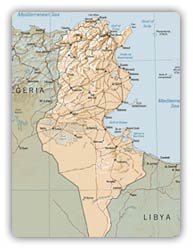
|

Relief and hydrography: The Mediterranean coast of Tunisia, long of 1 150 km, is notched by many natural ports and arms of the sea, in particular the gulfs of Tunis, Hammamet and Gabès. This last shelters the island of Jerba and the Kerkennah islands. To north, the buttresses relatively low of the Atlas cross the country in a south-western direction - the North-East. The altitude of the peaks oscillates between 610 and 1 520 Mr. Of the valleys and the fertile plains are boxed between the mountains of this area. The only major river of the country, ¦Medjerda¦, crosses the area of west in is, to emerge in the gulf of Tunis. More in the south, the mountains make place with a plate whose average altitude is approximately 600 Mr. Then, the plate drops gradually to the south until a succession of salted depressions, known under the name of sebkhas. They are in edge of the desert of the Sahara, which constitutes nearly 40 p. 100 of the surface of Tunisia

Climate: The climate of Tunisia, because of its long maritime frontage and of low altitudes, is of Mediterranean type. The temperatures reach an average of 10,6 C in January and 26,1 C in July. The north of the country is rather well sprinkled; the rain season, from October at May, is relatively long. While moving towards the south, the climate becomes gradually hotter and more dryness. Annual average precipitations are approximately 610 mm, with a strong variability. They decrease towards the south, and represent only approximately 178 mm per annum in the Sahara.

Resources: The flora of Tunisia, in the coastal areas, is similar to that of Europe of the South. The fertile and well sprinkled areas North are characterized by their many vineyards and their dense forests of cork oaks, of pines and genévriers¦. More in the south, the vegetation, adapted to the semi-arid climatic conditions, is of steppe type with a predominance of the esparto. In the arid areas of the extreme South, the oases are planted date palms. Hyenas, wild boars, jackals and gazelles count among the representatives of a rather abundant fauna. Offshore oil rig oil and the phosphates are the principal mineral resources of Tunisia. The phosphate layers are located in the south of the country.
|